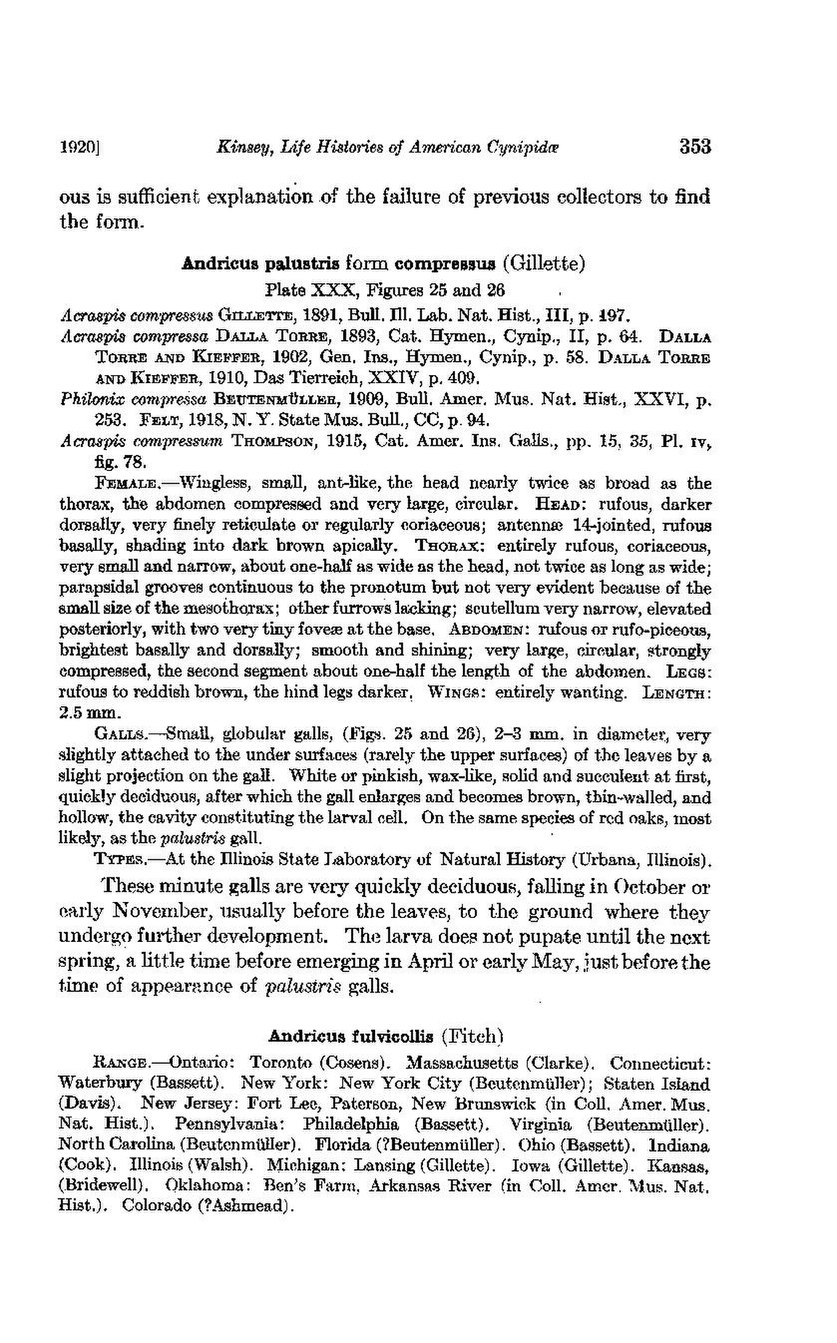ous is sufficient. explanation of the failure of previous collectors to findthe form.
Andricus palustris form compressus (Gillette)
Plate XXX, Figures 25 and 26
Acraspis compressus Gilette, 1891, Bull. Ill. Lab. Nat. Hist., III, p. 197.
Acraspis compressa Dalla Torre, 1893, Cat. Hymen., Cynip., II, p. 64. Dalla Torre and Kieffer, 1902, Gen. Ins., Hymen., Cynip., p. 58. Dalle Torre and Kieffer, 1910, Das Tierreich, XXIV, p. 409.
Philonix compressa Beutenmüller, 1909, Bull. Amer. Mus. Nat. Hist., XXVI, p. 253. Felt, 1918, N. Y. State Mus. Bull., CC, p. 94.
Acraspis compressum Thompson, 1915, Cat. Amer. Ins. Galls., pp. 15, 35, PI. iv, fig. 78.
Female.—Wingless, small, ant-like, the head nearly twice as broad as the thorax, the abdomen compressed and very large, circular. Head: rufous, darker dorsally, very finely reticulate or regularly coriaceous; antenne 14-jointed, rufous basally, shading into dark brown apically. Thorax: entirely rufous, coriaceous, very small and narrow, about one-half as wide as the head, not twice as long as wide; parapsidal grooves continuous to the pronotum but not very evident because of the small size of the mesothorax; other furrows lacking; scutellum very narrow, elevated posteriorly, with two very tiny fovee at the base. Abdomen: rufous or rufo-piceous, brightest basally and dorsally; smooth and shining; very large, circular, strongly compressed, the second segment about one-half the length of the abdomen. Legs: rufous to reddish brown, the hind legs darker. Wings: entirely wanting. Length: 2.5 mm. Galls.—Small, globular galls, (Figs. 25 and 26), 2-3 mm. in diameter, very slightly attached to the under surfaces (rarely the upper surfaces) of the leaves by a slight projection on the gall. White or pinkish, wax-like, solid and succulent at first, quickly deciduous, after which the gall enlarges and becomes brown, thin-walled, and hollow, the cavity constituting the larval cell. On the same species of red oaks, most likely, as the palustris gall.
Types.—At the Illinois State Laboratory of Natural History (Urbana, Illinois).
These minute galls are very quickly deciduous, falling in October or early November, usually before the leaves, to the ground where they undergo further development. The larva does not pupate until the next spring, a little time before emerging in April or early May, just before the time of appearance of palustris galls.
Andricus fulvicollis (Fitch)
Range.—Ontario: Toronto (Cosens). Massachusetts (Clarke). Connecticut: Waterbury (Bassett). New York: New York City (Beutenmiuller); Staten Island (Davis). New Jersey: Fort Lee, Paterson, New Brunswick (in Coll. Amer. Mus. Nat. Hist.). Pennsylvania: Philadelphia (Bassett). Virginia (Beutenmüller). North Carolina (Beutenmuller). Florida (?Beutenmuller). Ohio (Bassett). Indiana (Cook). Illinois (Walsh). Michigan: Lansing (Gillette). Iowa (Gillette). Kansas, (Bridewell). Oklahoma: Ben's Farm, Arkansas River (in Coll. Amer. Mus. Nat. Hist.). Colorado (?Ashmead).
